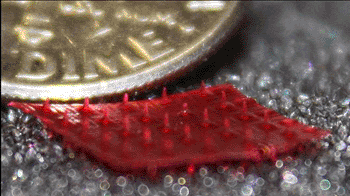Biomedical Engineers Create Silk Microneedles for Controlled-Release Drug Delivery
By LabMedica International staff writers
Posted on 04 Jan 2012
A publication described the manufacture and use of biodegradable and biocompatible “microneedles” as a minimally invasive drug delivery alternative to hypodermic needles.Posted on 04 Jan 2012
Microneedles, which are no more than a micrometer in size and able to penetrate the upper layer of the skin without reaching nerves, have been touted as a painless new drug delivery mechanism. However, their development has been limited by complications ranging from harsh manufacturing requirements that destroy sensitive biological compounds, to the inability to precisely control drug release or deliver sufficient drug volume, to problems with infections caused by the small skin punctures.

Image: Silk microneedles are being touted as a new drug delivery mechanism (Photo courtesy of Tufts University).
In the current study, investigators at Tufts University (Medford MA, USA) described the use of silk fibroin for the production of microneedles. Silk fibroin combines excellent mechanical properties, biocompatibility, biodegradability, benign processing conditions, and the ability to preserve and maintain the activity of biological compounds entrained in its material matrix. The degradation rate of silk fibroin and the diffusion rate of the entrained molecules can be controlled simply by adjusting postprocessing conditions.
The process described in the December 2, 2011, online edition of the journal Advanced Functional Materials was based on conditions of ambient pressure and temperature and aqueous processing. Aluminum microneedle molding masters were fabricated into needle arrays of about 500 micron needle height and tip radii of less than 10 microns. The elastomer polydimethylsiloxane (PDMS) was cast over the master to create a negative mold; a drug-loaded silk protein solution was then cast over the mold. Further processing through water vapor annealing, and mechanical and electronic exposures at various temperatures provided control over the permeability of the silk microneedles and their drug release kinetics.
Results showed that silk microneedles could deliver simultaneously a large-molecule, enzymatic model drug (horseradish peroxidase), and the antibiotic tetracycline at controlled rates while maintaining bioactivity.
“By adjusting the postprocessing conditions of the silk protein and varying the drying time of the silk protein, we were able to precisely control the drug release rates in laboratory experiments,” said senior author Dr. Fiorenzo Omenetto, professor of biomedical engineering at Tufts University. “The new system addresses long-standing drug delivery challenges, and we believe that the technology could also be applied to other biological storage applications.”
Related Links:
Tufts University














